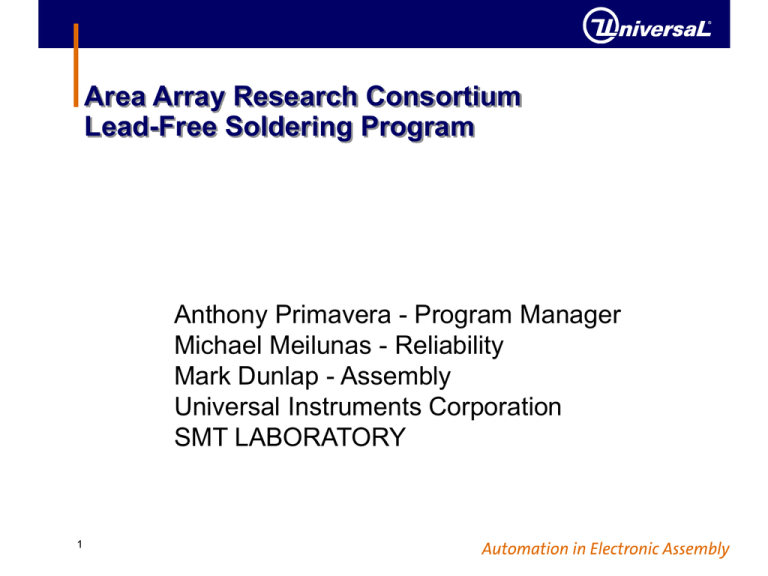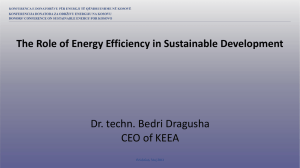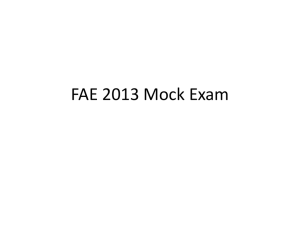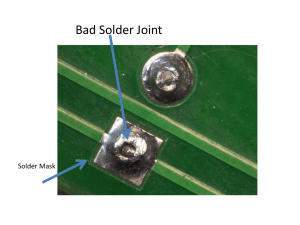Anthony Lead free cracking - Universal Instruments Corporation
advertisement

Area Array Research Consortium Lead-Free Soldering Program Anthony Primavera - Program Manager Michael Meilunas - Reliability Mark Dunlap - Assembly Universal Instruments Corporation SMT LABORATORY 1 Consortium Research Topics Lead Free Materials Evaluation Wetting of Lead Free Solder Alternative PCB Pad Finish Environmental Aging / Process & Storage Conditions Assembly Effects of Reflow Profile Self Centering / Pull back / Solderballing etc. Mixing of Alloys & Contamination Reliability Testing Commercially Available Component Fabrication of Test Vehicles Mechanical & Thermal Cycle Tests Determination of Solder Properties & Crack Growth Rate FEM Modeling 2 Reliability Testing Timeline Year 2000 Consortium Few Commercial Components Available Lead Free CSP/BGAs In Development Designed & Fabricated Generic Test Vehicles (Early 2000) Initial Testing Program I Begins (Mid 2000) Accelerated Thermal Cycle Testing of Lead Free BGAs Presentation of Initial Test Results for ATC (Late 2000) Year 2001 Consortium Follow on ATC Program II for Generic Lead Free BGAs Testing of Several Commercial Lead Free CSP/BGAs Development & Test of Generic Lead Free CSPs Year 2002 Consortium Wrap up of ATC Program II Follow on ATC Program III - Commercial & Generic BGAs 3 Early Results (Year 2000) Accelerated Thermal Cycle 0-100oC 20 min (5 min ramp & dwell) Continuous event detection Identification of electrical events Events not consistent with Sn/Pb solder fatigue ATC event detection Identification of failed joint difficult Events sporadic throughout testing Crack / Fatigue Sn/Pb baseline components failed by typical fatigue cracking lead-free solder joints have “unique shattered appearance” Lead-free cracks are multidirectional and are often very fine 4 Glitch or Electrical Event A glitch or event is defined as a false or spurious electronic signal. BGA devices that were continuously monitored while in thermal cycle displayed resistance “spikes” that sporadically occurred over several hundred cycles. These “spikes” were observed in Sn/Ag and Sn/Ag/Cu solder joints with nickel layers on both the component and printed circuit board pads. Cu Ni Ni Cu 5 Test Vehicle: FCPBGA • 256 I/O Daisy Chain • Utilizes Electroless Ni/ Immersion Au Pad Finish • 0.030” Diameter Spheres • 0.003” Encapsulant • 0.016” Laminate Substrate • 0.030” Glass Die • CTE of 11.1ppm/°C (Moiré Interferometry) Encapsulant Layer Solder Bumps Assembled to 0.062” FR-4 Based PCBs 6 Glass Die Generic Flip Chip PBGA (FCPBGA) Test Package BUMPED SUBSTRATE ( 30 mil Dia Solder Sphere, 1.1”Square Substrate with 256 BGA pattern) COPPER PAD ATTACHMENT (Copper Pads - 3 mils thick; used to obtain an uniform standoff) 7 ENCAPSULANT DISPENSE ON SUBSTRATE (Encapsulant used : Namics 8437-2) Generic Flip Chip PBGA (FCPBGA) Test Package GLASS PLACEMENT : Use of Glass Placement Fixture to center the die on the Substrate 8 Generic Flip Chip PBGA (FCPBGA) Test Package Unbalanced Component Component utilized in ATC Testing Both In-plane and out-of-plane deformation Balanced Component Component utilized in Crack Growth Rate Study. Predominately in-plane deformation Samples tested every N cycles in ATC, then subject to dye penetration testing Goal: correlation of crack area with number of thermal cycles 9 Assembly of Test Vehicles Consortium CSPTB2 4 Layer Construction: 2 Signal, 2 gnd Tetrafunctional FR4 170oC Tg Taiyo Prs4000 Mask 0.062” Nominal Thickness 2 Assembly Sites 21 Mil Circular Pads 26 Mil Mask Opening 23 Mil Circular Pads 28 Mil Mask Opening 10 Assembly of Test Vehicles CSPTB2 0.03” Sphere 14,130 cubic mils Approximately 80% transfer &50% solidified paste volume Vcone = 1/3h(r12 +r22 + r1r2) 11 Solder paste stencil 5 mil thick stainless steel Laser cut apertures, approximately 0.5 mil taper Circular apertures 21 mil circular pads 22.2 mil mean, 0.2 mil std dev. (top side) 22.8 mil mean, 0.2 mil std dev. (bottom side) Aperture Volume = 2005 cubic mils Solder Volume = 14,932 cubic mils 23 mil circular pads 24.2 mil mean, 0.2 mil std dev. (top side) 24.6 mil mean, 0.3 mil std dev. (bottom side) Aperture Volume = 2337 cubic mils Solder Volume = 15,065 cubic mils Experimental Test Matrix 1 Solder Alloy Sn/Ag (96.5/3.5) Sn/Ag/Cu (95.5/3.8/0.7) Sn/Ag/Cu/Sb (96.2/2.5/0.8/0.5) Sn/Pb (63/37) 12 PCB Finish Cu OSP Ni/Pd Ni/Au Cu OSP Ni/Pd Ni/Au Cu OSP Ni/Pd Ni/Au Cu OSP Ni/Pd Ni/Au Sample Size 8 8 8 8 8 8 8 8 8 8 8 8 Test Equipment UIC THERMAL PROFILE 10/16/00 120.00 100.00 Thermotron ATS 150 Two Zone Thermal Shock Chamber Thermal Cycle: 0 to 100°C 5 Minute Ramps 5 Minute Dwells Anatech 256 Event Detector Resistance Monitor 1.2mA Current (Fixed) 300 Threshold (UIC Setting) 200nS Sample Frequency (Fixed) PC Data Logging Temperature (Deg. C) 80.00 60.00 Series2 Series4 40.00 20.00 -20.00 13 Time (minutes) 38 36 34 32 30 28 26 24 22 20 18 16 14 12 8 10 6 4 2 0 0.00 Failure Criteria IPC-SM-785 Section 7.8: “Failure is defined as the first interruption of electrical continuity that is confirmed by 9 additional interruptions within an additional 10% of the cyclic life.” Event: • Electrical continuity interruption. Daisy chain loop resistance exceeds: • 300 , for >200nanoseconds UIC Criteria • 1000 for >1microsecond - IPC Criteria • Maximum 15 events per cycle. The frequency of the events per cycle increases as solder fracture increases. 14 Test Results (Matrix 1) Thermal cycling with no events until ~2700 cycles. Lead free FCPBGA packages began to demonstrate “Failure” characteristics. The samples were electrically continuous when tested with multimeter probe. Samples were cross sectioned or subject to a dye penetration test. • Fracture surfaces were minimal. The remaining samples were returned to thermal cycling. The electrical events were continued sporadically. Sn/Pb packages exhibited no failures. 15 Onset of Glitch vs. Confirmed Open 16 Failure Analysis Cross Sections of Glitch Failures Extremely fine cracks Incomplete Cracking Sn/Ag/Cu on Ni/Pd 3500 Cycles 17 Sn/Ag Alloy on Ni/Pd PCB 3500 Thermal Cycles Test Result Verification Noise Control: – New ground wires to the chamber, Anatech and PC were installed. – Anatech and PC wire shielding was replaced. – Placement within the chamber was rearranged. – Packages were firmly taped in place to minimize vibration. – Problem persisted. Manual Monitoring: – Visually (continuously) monitored Anatech output. – Noted that events occurred after basket transitions during the ramp up phase. 18 Test Result Verification Glitches Identified in 4 Groups: • Sn/Ag/Cu on Ni/Au PCB • Sn/Ag on Ni/Au PCB • Sn/Ag on Ni/Pd PCB • Sn/Ag/Cu on Ni/Pd PCB Apparent Trends: • All packages were bumped with Ag bearing alloys • Both PCB finishes contained Electroless Nickel • Events occurred in the ramp up phase • Sn/Pb samples showed no glitch / events • Sample assembled on Cu OSP pads showed no glitches Samples Pulled from Test: • Sn/Ag on Ni/Pd (4) • Sn/Ag/Cu on Ni/Au (4) • Sn/Ag on Ni/Au (3) • Sn/Ag/Cu on Ni/Pd (1) 19 Confirmation Experiments Reworked Samples • 29 reworked samples submitted for reliability testing • 26 packages utilized a Cu OSP pad finish • 3 utilized Sn/Ag Alloy on Ni/Pd pad finish • Glitch detected in 2 of the Sn/Ag on Ni/Pd samples • Occurred between 2000 and 2250 cycles Tests were Conducted on Existing Samples: • High temperature Probe • Oscilloscope monitoring • Resistance recording • Circuit reliability test • Elemental analysis 20 Characterization Experiments High Temperature Probe • Sample set on a hotplate (115°C) • Standard multimeter used • No opens located • Resistance changes noted Solder Alloy PCB Finish Sn/Ag/Cu Ni/Au Ni/Pd Sn/Ag Ni/Au 21 Resistance (Ohms) Hot Hot Ambient (Max) (Final) 4.05 4.71 4.71 7.72 15.26 10.58 7.55 13.38 9.55 3.00 24.10 5.71 2.82 19.23 4.93 4.63 6.20 6.20 5.62 27.89 7.24 Characterization Experiments Oscilloscope • Sample set on a hotplate (115°C) • Constant 10mA current applied • Continuous data of Voltage vs. Time • Glitch detected Sn/Ag on Ni/Pd (3500 Cycles) 22 Characterization Experiments Resistance Recording • Sample set on a hotplate (115°C) • Source Meter (10mA, 40mS Freq.) • Resistance spikes noted Sn/Ag on Ni/Pd 25 25 Resistance vs. Time Sn/Ag on Ni/Pd •Measured Events Resistance spikes as small as 5-10 20 Duration on order of nanoseconds. 15 Resistance (Ohms) 20 15 Ohms 10 Time (mS) Time (sec) 23 280505 272003 250 263502 255001 246514 238013 229512 221011 200 212510 204009 195508 187007 178506 170005 150 161504 153003 144502 136001 132300 128769 110512 93510 100 102011 85009 76508 68007 59506 50 51005 42504 34003 25502 17001 0 13 0 5 8513 5 10 Characterization Experiments Circuit Reliability Tester • Detects line reduction (Cracks) • Hotplate used to heat packages • Failures located • Corner solder joints SEM Analysis • Cross sectioned to failure locations • Performed elemental analysis Glitch Sample : Sn/Ag on Ni/Pd - 3500 Cycles Full Open Sn/Ag on Ni/Pd 8000 Cycles 24 Lead Free Crack Propagation Test • Balanced Construction • Samples Subjected to 0-100C ATC • 20 min test 5 min ramp and dwell • Samples pulled from test at fixed times • Samples subjected to dye penetration test Goal: • Measure crack growth rate for lead free alloys 25 Failure Analysis: Dye Penetration Testing Immerse in dye Dry dye at 100 C for 30 minutes 26 Place in vacuum (>/= 9 in Hg) for 1 minute then allow to soak for 1 hour Separate component by twisting of PWB Typical Sn/Pb Failure Lead Free Crack Growth Sn/Ag Results: • No clear growth rate measured • Dye failed to fully penetrate cracks • Cracking fundamentally “different” than Sn/Pb fatigue cracks Sn/Ag/Cu 27 Sn/Ag/Cu/Sb Test Matrix 2 - Year 2001 follow on A focus group was initiated to continue evaluation of lead free BGAs in a “round robin” set of tests UIC, IBM, Nokia, Motorola, Rockwell-Collins Board Ni/Au Cu-OSP ImmAg Cu-OSP Ni/Au IBM 16 16 0 8 16 Sn/Ag Ni/Au Ni/Au Ni/Au Cu-OSP Ni/Au Cu-OSP ImmAg Cu-OSP 32 32 0 24 32 32 0 0 16 8 0 0 0 0 32 0 32 8 0 0 112 80 32 24 Sn/Ag/Cu Ni/Au Ni/Au Ni/Au Cu-OSP Cu-OSP Ni/Au Cu-OSP ImmAg ImmAg Ni/Au 32 32 0 0 16 32 32 0 0 0 16 8 0 0 0 0 0 32 8 0 29 8 0 0 0 109 80 32 8 16 Sn/Ag/Cu/Sb Ni/Au Ni/Au Ni/Au Cu-OSP 16 16 16 16 8 8 0 0 40 24 80 64 Total Boards Req. 256 32 192 24 88 11 104 13 181 23 821 103 Sn/Pb 28 Component Sample Size Nokia Motorola Rockwell Universal 16 16 0 32 16 8 0 8 0 0 32 0 0 0 0 0 0 0 0 0 Component Ni/Au Ni/Au Ni/Au Cu-OSP Cu-OSP Total 80 48 32 8 16 Test Goals Confirmation of Test 1 results Evaluation of Lead-free BGAs under different ATC conditions Evaluation of Alternative PCB finishes Test Differences Round 1 NSMD Component Pads 1 ATC cycle (0-100C 20 min) 30 mil thick glass die (more warpage?) PCB pad finish - OSP, Ni/Au, Ni/Pd Round 2 SMD Component Pads Different Thermal Cycles 40 mil thick glass die PCB pad finish - OSP, Ni/Au, Imm Ag 29 Round 2 ACT Test Conditions: Continuous Event Detection 300 Resistance Threshold, 200 nanoseconds Universal IBM Motorola Nokia Rockwell Collins 0-100C, 20 min : 5 min ramp and dwell 0-100C, 32 minute: 7.5 min ramp, 8 min dwell 0-100C, 30 minute: 10 min ramp , 5 min dwell -40-125C, 60 minute: 15 min ramp and dwell -55-125C, 71 minute: approximately 15 min dwell* Assembly: UIC fabricated all test components & provided solder ball bumping UIC supplied PCBs, components and solder paste to each participant Each participant assembled the component to PCB (UIC TB6) 30 Assembly of Test Vehicles Consortium CSPTB6 4 Layer construction: 2 Signal, 2 gnd Tetrafunctional FR4 175oC Tg Taiyo Prs4000 mask 0.062” nominal thickness Assembly locations 20 mil circular pads 2 sites 25 mil mask opening 31 4 sites 22 mil circular pads 26 mil mask opening 2 sites 24 mil circular pads 28 mil mask opening Assembly of Test Vehicle CSPTB6 Solder paste stencil - Square apertures Laser cut 5 mil thick stainless steel 0.03” Sphere 14,130 cubic mils Approximately 90% transfer & 50% solidified paste volume Vtrap = h(l1w1 + l2w2)/2 32 20 mil circular pads 19.1 mil mean, 0.1 mil std dev. (top side) 20.1 mil mean, 0.1 mil std dev. (bottom side) Aperture Volume = 1922 cubic mils Solder Volume = 14,995 cubic mils 22 mil circular pads 21.2 mil mean, 0.1 mil std dev. (top side) 22.2 mil mean, 0.1 mil std dev. (bottom side) Aperture Volume = 2356 cubic mils Solder Volume = 15,190 cubic mils 24 mil circular pads 23.2 mil mean, 0.2 mil std dev. (top side) 24.1 mil mean, 0.2 mil std dev. (bottom side) Aperture Volume = 2798 Solder Volume = 15,389 Assembly of Test Vehicle CSPTB6 Assembly Results UIC •Several components showed underfill to die delamination, due to insufficient pre-bake. •Several “Ni/Au” component early failures Nokia •Voids observed in Sn/Ag/Cu/Sb samples •Several “Ni/Au” component pad early failures Rockwell-Collins •Sn/Ag/Cu paste utilized in all combinations. IBM •Several “Ni/Au” component pad early failures Motorola •Several “Ni/Au” component pad early failures 33 General Round 2 Information SAC on ImmAg Testing completed “substantial” number of cycles at each location UIC > 16,700 cycles Nokia > 7,000 Motorola > 13,700 Rockwell > 2,000 IBM > 13,500 Cracking - Fine in appearance, multiple crack fronts and paths Failure time - earlier on Ni/Au than OSP for some test cells. “Glitch behavior” noted in several lead free BGAs with Ni/Au pads 34 SA on ImmAg Failure on ImmAg - Rockwell Collins -55 to 125C ATC Failure near Cu-Sn intermetallic layer High amounts of Sn-Ag near cracks Cracks “go around” Sn-Ag plates Micro-voiding observed near crack SnAgCu on ImmAg 1544 cycles Sn-Ag Micro Voids Cu-Sn SnAg on ImmAg 1528 cycles 35 Confirmation of Glitch Behavior? “Glitch behavior” - Sporadic events for >100’s of cycles Motorola 2 samples Sn/Ag/Cu on Ni/Au pads UIC (note most samples pulled from test after first events) 2 samples Sn/Ag/Cu on Ni/Au pads 1 sample Sn/Ag/Cu/Sb on Ni/Au Nokia 1 sample Sn/Ag/Cu on Ni/Au pads 1 sample Sn/Ag on Ni/Au pads 1 sample Sn/Ag on OSP pads 2 samples Sn/Ag/Cu/Sb on Ni/Au pads 1 sample Sn/Ag/Cu/Sb on OSP 36 Other Lead Free Testing - Generic FCCSP Generic CSP size package 0.8 mm pitch 64 I/O Similar construction to generic BGA 0.02” lead free & Sn/Pb solder bumps Assembled on OSP, Ni/Au and ImmAg PCBs 0-100C ATC testing Mixed assembly (ie. SAC bump & Sn/Pb paste) Samples through 8,000 cycles 37 FCCSP Test Results Sn/Ag/Cu/Sb on ImmAg Lead-free solder samples show similar crack behavior to BGA testing Mixed samples showed some failures at Ni layer Ag-Sn intermetallic Cu-Sn intermetallic Early Fail (<2000 cycles) Near Ni layer 38 Sn/Ag/Cu/Sb/Pb mixed on Ni/Au Generic FCCSP Test Results Ag-Sn Early Failure on ImmAg In general ATC - OSP> NiAu Similar to BGA data on ImmAg FCCSP Data - 7,000 cycles Failure near and around intermetallic layers Presence of micro voids Cu-Sn Micro Voids Sn/Ag/Cu on ImmAg Good joint approximately 2500 cycles 39 FCCSP ACT Results 0-100C Predicted OSP failure with B=5 OSP Data Set not enough fails for accurate plot 40







